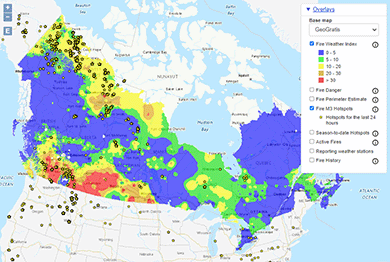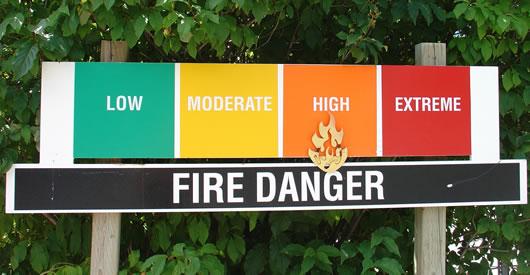
Fire has a crucial role in shaping forests across Canada. It is a vital ecological process that supports forest health and diversity. However, wildland fires can harm our health, well-being, communities, plus cultural and economic resources.
The 2023 wildland fire season was historic.
- Over 230,000 persons were evacuated because of potential dangers to life and health.
- Over 6,800 wildland fires burned more than 14.6 million hectares (ha) of Canada’s forest area. (Source: National Burned Area Composite)
In comparison, over 8,000 wildland fires occur annually and burn an average of more than 2.1 million ha (Source: National Forestry Database).
Knowing the causes, severity and other related patterns can help us address future wildland fire challenges.
What is wildland fire
Wildland fire is any ignition, natural or planned, that burns in wildland areas and consumes natural fuels (trees, brush, grass, etc.). Forest fires, grassland fires, cultural fires and prescribed fires are all considered wildland fires.
Many factors influence the size and behaviour of wildland fire, including landscape, wind and weather patterns. No matter how a fire starts, the possibility of large, damaging wildland fires always exists.
Warmer-than-average temperatures, decreased levels of snowpack, low soil moisture and elevated drought conditions are indicators that climate change is impacting the frequency, size and range of wildland fires in Canada. For example, the number of over-wintering fires is increasing.
Building Resilience
In Canada, managing wildland fire is a shared responsibility between all orders of government. Provincial and territorial governments, in cooperation with local authorities, decide whether to and how to control wildland fires within their jurisdictions. The federal government makes decisions about wildland fires on federal lands, such as in national parks.
The wildland-urban interface (WUI) is where human development interacts with the natural environment. Embers from a nearby wildland fire can have drastic impacts. WUI fires are often complex and challenging to extinguish because of the combination of natural (vegetation) and built fuels (infrastructure). FireSmart® Canada helps Canadians increase their resilience to wildland fire and minimize its negative impacts. The program’s resources are designed to empower the public by providing advice about protecting homes and communities.
The growing number and complexity of wildland fires indicate that no government or organization can tackle the challenge of wildland fires alone. Around the world, whole-of-society involvement, where everyone works together to reduce risks, increase resilience and reduce losses, is increasingly recognized as a foundational approach to preventing and mitigating wildland fire.
Understanding the need for a clear path forward, the Canadian Council of Forest Ministers (CCFM) developed the Canadian Wildland Fire Prevention and Mitigation Strategy. This Strategy reflects over two years of engagement by the CCFM with municipal, provincial, territorial, federal and self-governments, First Nations, Inuit, and Métis representatives, academia, industry, and many others across Canada. Together, our combined efforts can build a more wildland fire resilient society.
Wildland fire suppression

Fire danger roadside signs are based on elements of Canada's Fire Weather Index (FWI) system, an important component of the CFFDRS.
The Canadian Forest Fire Danger Rating System (CFFDRS) is the principal source of fire information for all wildland fire management agencies across Canada. It is a system of scientific models used to assess fire danger and estimate fire behaviour. This national system is also the most widely applied fire danger rating system in the world.
Sharing trained personnel, equipment and knowledge is fundamental to putting out wildland fires. When necessary, the Canadian Interagency Forest Fire Centre (CIFFC) helps with the exchange of wildland fire fighting personnel, aircraft, equipment and information between jurisdictions. The CIFFC also assists with the exchange of resources between international partners. Mutual aid is the foundation of national and international wildland fire suppression.
The Fighting and Managing Wildfires in a Changing Climate program provides funding for the training of wildland firefighters and the purchasing of equipment to enhance wildland fire management across Canada.
Wildland fire science
The Canadian Forest Service (CFS) conducts internationally recognized wildland fire science and technology development. Strong relationships with Provincial and Territorial governments and Indigenous partners support our scientific and technical expertise.
Our Blueprint for Wildland Fire Science in Canada (2019-2029) is a strategic 10-year plan of action focused on building national wildland fire science capacity. It identifies existing gaps, priority topics, and outlines recommendations to enhance wildland fire research.
Launched in 2024, the Wildfire Resilient Futures Initiative funds activities transforming how Canada manages wildland fire.